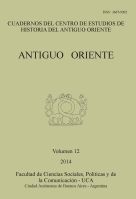Por favor, use este identificador para citar o enlazar este ítem:
https://repositorio.uca.edu.ar/handle/123456789/6791| Título: | The self-destruction of diversity” : a tale of the last days in judah's Negev towns “La autodestrucción de la diversidad”: Una historia de los últimos días en las ciudades del Negev de Judá |
Autor: | Thareani, Yifat | Palabras clave: | HISTORIA ANTIGUA; EDAD DE HIERRO; GRUPOS ETNICOS; HISTORIA POLITICA; HISTORIA SOCIAL; ARQUEOLOGIA; PALEOGRAFIA | Fecha de publicación: | 2014 | Editorial: | Pontificia Universidad Católica Argentina. Facultad de Ciencias Sociales, Políticas y de la Comunicación. Centro de Estudios de Historia del Antiguo Oriente | Cita: | Thareani, YY. "The self-destruction of diversity” : a tale of the last days in judah's Negev towns [en línea]. Antiguo Oriente. Cuadernos del Centro de Estudios de Historia del Antiguo Oriente. 2014, 12 Disponible en: https://repositorio.uca.edu.ar/handle/123456789/6791 | Resumen: | Abstract: The prosperous settlement system that developed in the Negev desert frontier towards the late Iron Age was characterized by the presence of various ethnic groups, including permanently settled and nomadic elements—most of whom took part in the longdistance Arabian trade. This multicultural reality experienced by Judeans, Edomites and Arabs is reflected in the rich archaeological and paleographical assemblages uncovered in Negev towns, attesting to diverse stylistic traditions. Alas, the flourishing urban system came to an abrupt end—marked by heavy destruction layers and abandonment patterns—which altered the region’s settlement system and subsistence economy for many years to come. Traditionally scholars have suggested that one of two malefactors brought about this violent end: the Babylonian empire or the Edomite kingdom—that is, external forces. A renewed study of late Iron Age IIc material culture from Negev sites has identified a third possibility. According to this reconstruction, following the decline of the Assyrian empire, Iron Age II Negev society experienced increasing socio-ethnic tension between local semi-nomads of an Edomite orientation on the one hand and on the other Judean sedentary groups. This escalating conflict eventually led to the inevitable collapse of a delicate symbiosis which had flourished in the region for over a century. Resumen: El sistema próspero de asentamientos que se desarrolló en la frontera del desierto del Negev hacia fines de la Edad de Hierro se caracterizó por la presencia de varios grupos étnicos, incluyendo asentamientos permanentes y elementos nomádicos— muchos de los cuales participaron del comercio arábigo de larga distancia. Esta realidad multicultural experimentada por judaítas, edomitas y árabes está reflejada en los ricos conjuntos arqueológicos y paleográficos descubiertos en las ciudades del Negev, atestiguando las diversas tradiciones estilísticas. Por desgracia, el floreciente sistema urbano llegó a un abrupto fin—marcado por una fuerte destrucción de estratos y patrones de abandono—el cual alteró el sistema de asentamientos de la región y la economía de subsistencia durante muchos años. Tradicionalmente, los investigadores han sugerido que uno de dos villanos ocasionó este violento fin: el imperio babilónico o el reino edomita—esto es, fuerzas externas. Un estudio renovado de la cultura material de finales de la Edad de Hierro IIc identifica una tercera posibilidad. De acuerdo con esta reconstrucción, siguiendo el declive del imperio asirio, la sociedad de la Edad de Hierro II del Negev experimentó un incremento en la tensión socio-étnica entre grupos semi-nómades de orientación edomita por un lado y, por el otro, grupos sedentarios judaítas. Este conflicto ascendente llegó eventualmente al colapso inevitable de una delicada simbiosis que había florecido en la región por más de un siglo. |
Cobertura Espacial: | ISRAEL | URI: | https://repositorio.uca.edu.ar/handle/123456789/6791 | ISSN: | 1667-9202 | Disciplina: | ARQUEOLOGIA | Derechos: | Acceso Abierto | Fuente: | Antiguo Oriente. Cuadernos del Centro de Estudios de Historia del Antiguo Oriente. 2014, 12 |
| Aparece en las colecciones: | AO - 2014 vol. 12 |
Ficheros en este ítem:
| Fichero | Descripción | Tamaño | Formato | |
|---|---|---|---|---|
| self-destruction-diversity-negev-towns.pdf | 336,69 kB | Adobe PDF |  Visualizar/Abrir |
Visualizaciones de página(s)
209
comprobado en 30-abr-2024
Descarga(s)
102
comprobado en 30-abr-2024
Google ScholarTM
Ver en Google Scholar
Este ítem está sujeto a una Licencia Creative Commons

